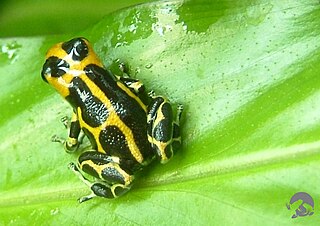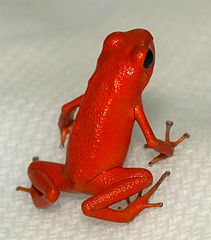Be it the discovery of a new species in the middle of NYC or the revelation that Mimic Poison Frogs are monogamous, frog enthusiasts are accustomed to surprises. But those revealed in the last few years have been especially interesting and unexpected…frogs with sheathed claws, tadpoles that feed upon their father’s skin and on tree bark, bird-eating, bird-voiced and lungless frogs, fanged tadpoles and much, much more. Were I new to this field, I’d consider much of the following article as pure fantasy…but even after a lifetime of working with amphibians, I’m still shaking my head.
Note: please see the linked articles for further information on the frogs introduced here.
Fangs and Bird-Like Songs: Surprises from Vietnam
Several years ago, Dr. Jodi Rowley of the Australia Museum discovered a new species of gliding frog in the montane forests of southern Vietnam’s Langbian Plateau. Exciting enough to be sure…until it was revealed that this frog’s tadpoles sport hard, sharp, fang-like structures that arise from the lower jaw! The newly-described Vampire Flying Frog, Rhacophorus vampyrus, deposits eggs in water-filled tree hollows high above the ground, but as yet we know little about the natural history of its most unusual tadpoles.
Amazingly, Dr. Rowley also discovered another frog, the Quang’s Treefrog, Gracixalus quangi, and it too is quite unique. In contrast to most frogs, males of this species issue forth with a series of clicks, whistles and chirps during the breeding season. Not only are the calls musical to the point of being “bird-like”, they are also very complex, with no predictable sequence. You can listen to a recording of this denizen of northern Vietnam’s high-altitude forests here.
The Oddest Tadpole Diets Yet Discovered
Predatory, egg-eating and filter-feeding tadpoles, interesting as they may be, take a back seat to those of India’s Brown Leaping Frog, Indirana semipalmata. Not only do they feed upon tree bark – the only tadpoles known to do so – but they live in trees. And they do not spend their time in water-filled tree hollows, but rather clinging to tree branches! Frequent rain showers apparently keep them from dehydrating.
Tadpoles of the recently discovered Fringe-Limbed Treefrog, Ecnomiohyla rabborum, take unusual feeding habits a step further. They favor the living skin of their male parent! This behavior has been documented in some caecilians (in which case the female provides “dinner”), but was not suspected to occur in frogs. Male Fringe-Limbed Treefrogs appear to guard their tree hollow nest sites even outside of the breeding season, a form of territoriality that is quite rare among amphibians. Much remains to be learned about this species which, as of now, is known only from a single mountainous rainforest in Coclé, central Panama.
More Frog Oddities
Several other newly-described frogs have also caused herpetologists to re-think certain long-held beliefs. The Perret’s Night Frog (Aslyloternus perreti), for example, has sharp claws that burst through the skin when needed! Claws (actually elongated toe bones) used in this manner are unknown in any other vertebrate. This largely unstudied frog appears confined to western Cameroon, Africa.
The Bornean Flat-Headed Frog (Barbouk kalimantensis) was discovered in 1978, but remained relatively forgotten thereafter (in the following 20 years, only 2 individuals were collected). Interest was revived recently, however, when a dissection revealed that it is the only known lungless frog. Limited in range to the Kapaus River basin in western Kalimantan, Borneo, it inhabits cold, swiftly-moving streams, and apparently relies upon cutaneous respiration.
Thailand’s Khorat Big-Headed Frog (Limnonectes megastomias) is aquatic, and uses its long, sharp fangs to ambush birds and other frogs at the water’s edge. These formidable weapons may also be used during battles over mates or territories, as males frequently bear missing toes and puncture wounds. As with most newly-discovered frogs, much of its natural history remains a mystery.
Further Reading
Skin Feeding Tadpoles (Fringe-Limbed Treefrog)
Discovery of the Vampire Flying Frog
Fanged, Bird-Eating Frog Found in Thailand
New-found Frog Defends Itself with Skin-Sheathed Claws
 That Reptile Blog – Reptile, Amphibian and Exotic Pet Care and Information
That Reptile Blog – Reptile, Amphibian and Exotic Pet Care and Information





